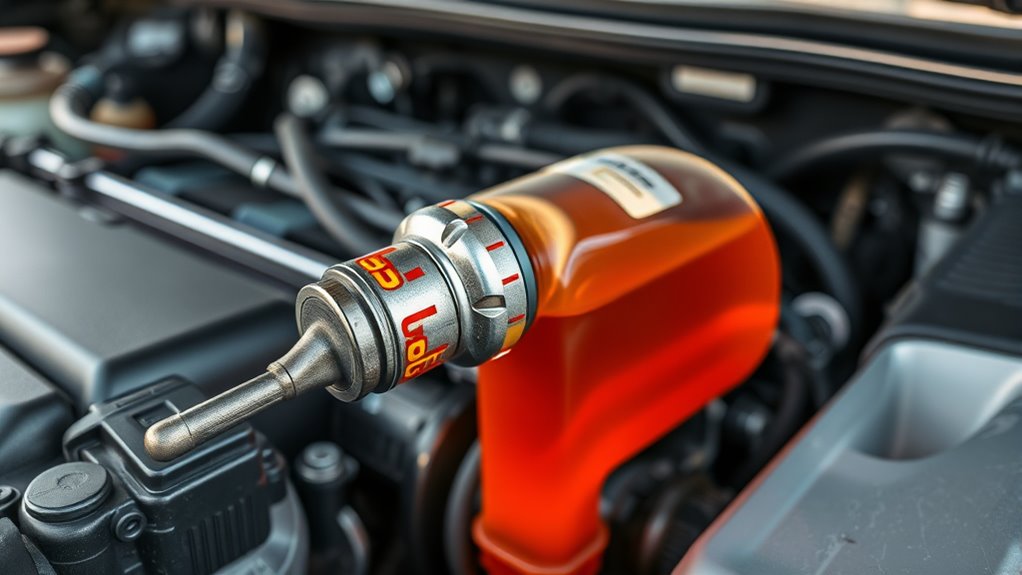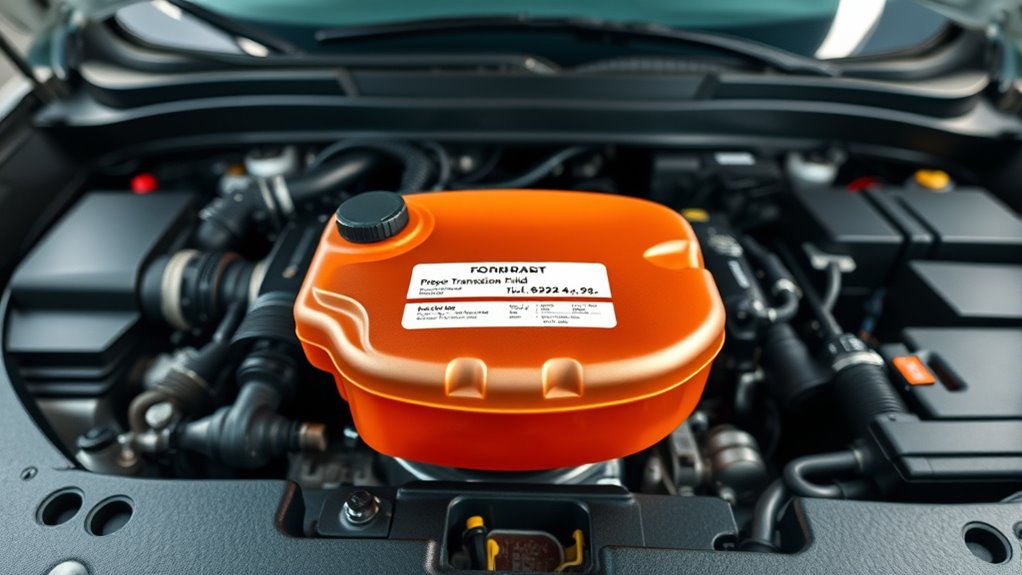For your Ford Transit, using the right transmission fluid is key—most late-model models need Motorcraft MERCON V or LV, depending on your transmission type. Change the fluid every 30,000 miles or sooner if you notice slipping, rough shifts, or color changes. Synthetic fluids like Valvoline offer extra protection and longer intervals. Staying with OEM-approved fluids and regular maintenance helps guarantee your Transit runs smoothly; keep exploring to learn more about proper fluid choices and intervals.
Key Takeaways
- Most late-model Ford Transit automatic transmissions use Mercon V or Mercon LV transmission fluid, depending on the model and transmission type.
- Ford recommends changing the transmission fluid every 30,000 to 60,000 miles for optimal performance.
- Signs indicating a fluid change include slipping gears, delayed shifts, or dark, dirty fluid appearance.
- Synthetic fluids like Motorcraft Mercon LV offer longer service intervals and better thermal stability.
- Always verify the owner’s manual for specific fluid type and recommended change intervals for your Transit model.
Overview of Ford Transit Transmission Fluid Types

Understanding the different types of Ford Transit transmission fluid is essential to guarantee peak performance and avoid costly repairs. Ford recommends Motorcraft transmission fluids, designed specifically for their vehicles, offering low viscosity for better flow in cold weather and additives that prevent varnish and sludge buildup. For newer models, synthetic options like Valvoline Dexron-VI/Mercon LV ATF provide advanced additives that exceed Ford’s standards, especially under high temperatures and heavy loads. In emergencies, SAE 75W-90 gear oil can temporarily safeguard your transmission until proper fluid is added, but it’s not a long-term solution. Always check your owner’s manual to match the transmission fluid’s specifications—like Dexron VI or Mercon LV—to ensure compatibility and maintain your Transit’s performance. Proper maintenance intervals are crucial for ensuring optimal transmission function and longevity. Additionally, using the correct fluid type helps prevent transmission wear, which can lead to costly repairs if neglected.
Recommended Fluids for Different Transit Models

Different Ford Transit models require specific transmission fluids to guarantee *ideal* performance and longevity. Most late-model Transits with traditional automatic transmissions use Mercon V, which is compatible with older transmissions but not suitable for models requiring Ford Type F fluid. For newer six-speed transmissions, Mercon LV is recommended, offering improved shear strength and efficiency. Starting around 2018, some models with 10R80 transmissions need Mercon ULV, designed for tighter tolerances and better fuel economy. Variants with dual clutch transmissions (DCT) demand specialized DCT fluids, not interchangeable with ATF. Additionally, transmission fluid choice depends on engine type and production year; for example, older models with 3.5L engines often use Mercon LV, while newer turbo and diesel engines typically require ULV. Always verify compatibility with your specific Transit model. Transmission fluid selection is crucial for ensuring smooth shifting and preventing potential damage to your vehicle’s transmission. Proper fluid maintenance can also extend the lifespan of your transmission and improve overall vehicle performance.
Determining When to Change the Transmission Fluid

Knowing when to change your Ford Transit’s transmission fluid is key to maintaining smooth operation and avoiding costly repairs. Watch for signs like slipping gears, where the engine revs but the vehicle doesn’t accelerate, or delayed, harsh shifts that signal degraded fluid. Check the fluid’s color—dark or dirty fluid indicates contamination and the need for a change; fresh fluid is typically bright red and clear. Unusual noises or overheating can also point to fluid breakdown or low levels. Refer to your owner’s manual for specific intervals; most recommend every 30,000 miles, though some models may go up to 150,000 miles under low-use conditions. Regularly inspecting fluid condition and performance symptoms helps determine the right time for a change, beyond just mileage. Routine maintenance is essential for keeping the transmission operating smoothly and extending its lifespan. Additionally, considering transmission fluid type is crucial for ensuring compatibility and optimal performance. Being aware of international holiday influences, such as Western media’s impact on festivities like Halloween, can also inform your understanding of vehicle usage patterns during seasonal events. Proper fluid fluid change intervals ensure your transmission remains reliable and efficient.
Benefits of Using Synthetic Transmission Fluids

Using synthetic transmission fluids offers the benefit of enhanced thermal stability, so your transmission stays protected even under heavy loads or high temperatures. This stability allows for longer service intervals, saving you time and money on maintenance. Overall, synthetic fluids help your Ford Transit perform reliably in extreme conditions while reducing the need for frequent fluid changes. Additionally, advanced techniques in synthetic formulations further improve the longevity and efficiency of your transmission. Incorporating high-quality synthetic oils can also contribute to smoother shifting and better overall vehicle performance, especially when paired with appropriate tuning upgrades that optimize transmission response. Moreover, understanding dog quotes for reflection and humor can provide a lighthearted perspective on vehicle maintenance routines.
Enhanced Thermal Stability
Synthetic transmission fluids offer exceptional thermal stability, which means they withstand breakdown and degradation even under extreme high-temperature conditions. This helps prevent sludge, varnish, and deposit buildup that can impair your transmission’s performance. With better oxidation resistance, synthetics maintain their viscosity and lubricity longer, protecting components from wear caused by acid buildup and contaminants. Plus, their high-temperature lubrication performance ensures consistent film strength, reducing metal-to-metal contact and wear during intense driving. They also excel in low-temperature environments, flowing quickly at cold starts for smoother operation. Additionally, their superior heat dissipation keeps temperatures stable, preventing overheating and extending fluid life. Advanced neural network integration in synthetic fluids further optimizes flow characteristics for enhanced performance. Incorporating thermal stability in synthetic transmission fluids not only enhances durability but also contributes to overall transmission longevity by maintaining optimal operating conditions. Proper use of synthetic transmission fluids can significantly extend transmission lifespan and improve vehicle reliability.
Extended Service Intervals
Thanks to their enhanced thermal stability and resistance to breakdown, synthetic transmission fluids allow you to extend the intervals between fluid changes considerably. They maintain stable viscosity over wide temperature ranges, reducing fluid degradation and deposit formation. This means you can often go up to 100,000-150,000 miles between changes, compared to 30,000-60,000 miles with conventional fluids. Their superior shear stability and anti-wear additives protect transmission components longer, preserving efficiency. Additionally, their resistance to oxidation and thermal breakdown keeps the transmission cleaner, preventing sludge buildup. Compatibility with modern transmission materials prevents leaks and leaks, reducing maintenance issues. These benefits lower overall costs and environmental impact. Incorporating advanced sound design techniques in diagnostics and maintenance procedures can further optimize transmission longevity.
Step-by-Step Transmission Fluid Change Procedure

To change the transmission fluid in your Ford Transit, start by preparing the vehicle and tools. Park on a level surface, engage the parking brake, and raise the vehicle with a jack, securing it on jack stands. Gather your tools: socket, transmission fluid pump, ratchet, torque wrench, funnel, catch pan, rags, and Mercon LV fluid. Have replacement parts ready, like a new filter or gasket, and wear gloves and safety glasses. To ensure proper maintenance and avoid costly repairs, consult your vehicle’s service schedule for specific change intervals. Regular maintenance, such as transmission fluid checks, can help prolong the life of your transmission. Additionally, maintaining proper fluid levels is essential for optimal transmission performance.
- Drain old fluid by loosening the drain plug with a ratchet, catching fluid in a pan, and replacing the gasket if needed.
- Remove transmission pan bolts, lower the pan, and replace the filter if applicable.
- Refill with new fluid through the fill tube, avoiding overfill.
- Start engine, warm up, check levels, and add fluid as necessary.
Ensuring Compatibility and Proper Fluid Selection

To keep your Ford Transit running smoothly, guarantee to match the transmission fluid with Ford’s specifications. Using OEM or approved fluids ensures compatibility and protects your transmission from damage. Always double-check your owner’s manual to select the right fluid for your model.
Matching Ford Specifications
Matching Ford specifications when selecting transmission fluid is crucial to guarantee your vehicle’s transmission operates smoothly and remains protected from damage. Using the correct fluid type maintains proper frictional properties, preventing wear and costly repairs. Make sure the fluid meets or exceeds Ford’s MERCON LV for 6-speed transmissions or MERCON ULV for 8-speed models. Incompatible fluids can cause sludge buildup, varnish formation, and reduced hydraulic efficiency. To verify compatibility, consider these points:
- Verify the fluid’s Ford part number (e.g., M465QULV-1) matches OEM requirements.
- Confirm the fluid’s specification aligns with your transmission model.
- Avoid mixing different fluid types or brands unless explicitly approved.
- Consult your owner’s manual or dealer to double-check compatibility before purchase.
Proper matching preserves lubrication, shift quality, and transmission lifespan.
Using OEM or Approved Fluids
Choosing OEM or approved transmission fluids is essential because they’re specifically formulated to meet Ford’s strict performance standards. These fluids are designed to match Ford’s frictional and viscosity requirements, ensuring your transmission operates smoothly and efficiently. Using non-approved fluids can cause premature wear, clutch slippage, and damage to internal parts like synchronizers. OEM fluids contain specialized additives that reduce varnish, sludge buildup, and wear, helping extend transmission life. They’re tested under real-world conditions to guarantee compatibility with Ford’s materials and components. For manual transmissions, avoid GL-5 oils with high sulfur content that can harm bronze synchronizers. For automatics, use Ford’s Motorcraft fluids like MERCON LV or ULV for optimal performance. Proper fluid choice maintains shifting quality, protects internal components, and preserves your transmission’s reliability. Additionally, selecting the right fluid can be supported by understanding personality traits, which can influence how you approach vehicle maintenance and care. Ensuring proper fluid compatibility can prevent common issues like slipping or overheating, ultimately extending the lifespan of your transmission.
Key Factors Influencing Fluid Change Intervals

Several key factors influence how often you should change the transmission fluid in your Ford Transit. First, your driving conditions play a major role; heavy loads, towing, and stop-and-go city driving speed up fluid degradation. Second, vehicle usage and mileage matter—high-mileage or commercial vehicles benefit from more frequent changes to prevent wear. Third, the type and quality of fluid used impact maintenance needs; incompatible or low-quality fluids can shorten fluid life. Fourth, maintenance practices like regular inspections and timely filter changes help maintain transmission health. Additionally, understanding the potential Pitfalls of new payment technologies can inform your maintenance choices and ensure compliance.
Frequently Asked Questions
Can I Use Aftermarket Transmission Fluids in My Ford Transit?
Yes, you can use aftermarket transmission fluids in your Ford Transit, but make sure they meet Ford’s specifications like MERCON LV or ULV. Always check the label to confirm compatibility and avoid fluids with incompatible additives or ratings like GL-5 in manual transmissions. Monitor your transmission’s performance closely, and consider switching back to OEM Motorcraft fluids if you notice shifting issues or unusual behavior.
How Do I Check the Transmission Fluid Level on Sealed Models?
Imagine you’re checking your sealed Ford Transit’s transmission fluid after a long trip. You’ll need to warm up the engine, then locate the check/fill plug, usually on the side or bottom of the transmission. With the engine running and in park, carefully remove the plug—fluid should be level with or slightly trickling out. If low, add recommended fluid slowly, then recheck to guarantee proper level before tightening the plug securely.
What Are Signs Indicating I Need a Transmission Fluid Change?
You need a transmission fluid change if you notice dark brown or black fluid, a burnt smell, or fluid leaks underneath your vehicle. Also, watch for slipping gears, rough shifting, grinding noises, or delays in gear engagement. If your transmission feels jerky or hesitant, these are signs the fluid has degraded. Regularly check the fluid’s color, smell, and level, and change it promptly to prevent further damage.
Is It Necessary to Flush the Transmission During Fluid Replacement?
Think of your transmission fluid as the bloodstream of your vehicle—keeping it healthy is vital. Generally, a flush isn’t necessary during fluid replacement unless the fluid is very dark, dirty, or contaminated. Regular fluid changes usually suffice to keep everything running smoothly. Only consider a flush if symptoms like rough shifting, burning smell, or debris in the fluid appear, as unnecessary flushing can do more harm than good.
Are There Specific Transmission Fluid Requirements for High-Mileage Transits?
Yes, high-mileage Transits often require specific transmission fluids designed for aging seals and reduced leaks. You should look for fluids with additives that improve friction stability and anti-wear properties, like Mercon LV, which is recommended by Ford. Using the right fluid helps prevent slip and wear, especially in older vehicles. Regularly check fluid condition and change it more frequently to keep your high-mileage Transit running smoothly and extend its lifespan.
Conclusion
Now that you know the right fluid types and change intervals, imagine your Ford Transit gliding smoothly down the road, engine humming quietly. But beware—overlooking these details could lead to sudden shifts or costly repairs. Will you risk it? Stay vigilant, follow the proper maintenance steps, and keep that transmission running like new. The road ahead is yours to conquer—just remember, timely fluid changes could be your secret weapon for a trouble-free journey.









